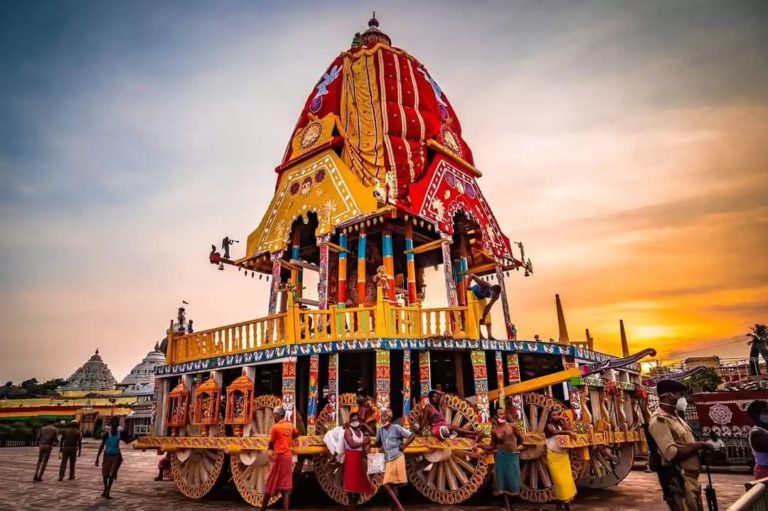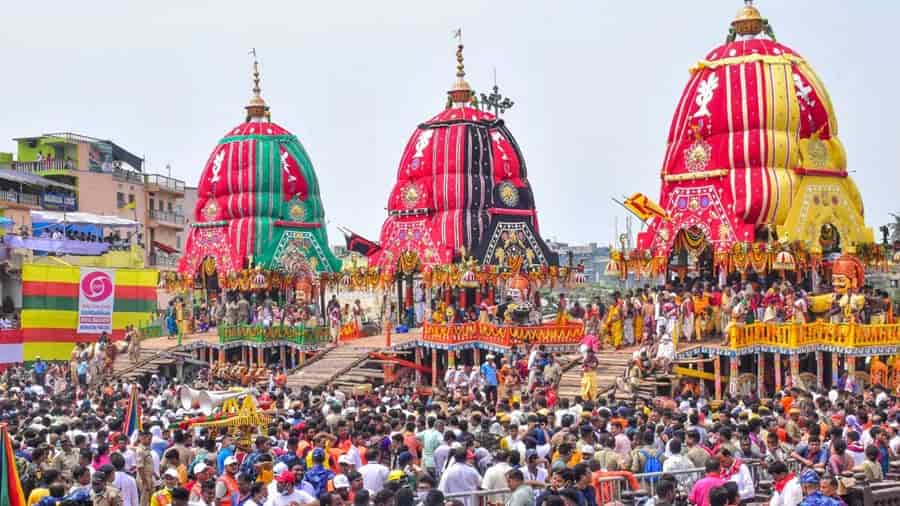- General
- Updated on June 28, 2025
History & Significance: Origins of the Jagannath Rath Yatra Explained

The Jagannath Rath Yatra is one of India’s most spectacular religious processions, drawing millions of devotees to Puri, Odisha each year. Literally “chariot journey,” this festival transports the deities Jagannath, Balabhadra, and Subhadra from the Jagannath Temple to the Gundicha Temple. Beyond its colorful pageantry, the Rath Yatra embodies centuries-old mythology, royal patronage, and social unity. In this article, we delve into the festival’s ancient origins, evolving rituals, cultural impact, and modern-day significance.
Ancient Origins and Mythological Roots

At the heart of Rath Yatra lies the legend of Lord Jagannath—an avatar of Vishnu—whose unconventional wooden form and chariot journey symbolize cosmic themes of renewal and inclusivity.
Stories of Lord Jagannath and the Chariot Festival
According to Odia tradition, King Indradyumna of Malwa dreamt of finding a wooden log floating in the sea, which he carved into the triad of Jagannath (the Lord of the Universe), his elder brother Balabhadra, and sister Subhadra. When these deities first emerged, they refused to reside permanently within the temple sanctuary, insisting instead on visiting their birthplace at the Gundicha Temple each year. Their annual journey became the prototype for Rath Yatra, emphasizing the Lord’s willingness to mingle with devotees outside the temple walls.
Textual References in Puranas and Chronicles
The Skanda Purana and Padma Purana contain early mentions of Rath Yatra, linking it to Krishna’s Rasa Lila and the solar cycle. Medieval Odia texts such as the Dandi Ramayana (15th century) provide vivid details of chariot construction and festival rituals, cementing Rath Yatra’s place in regional lore. These sources emphasize how the festival marks the summer solstice and agricultural renewal, weaving spiritual and seasonal significance.
Evolution Over Centuries
Rath Yatra has undergone transformations under various dynasties and reformers, reflecting changing political and artistic sensibilities.
Temple Construction and Royal Patronage
The present Jagannath Temple, attributed to King Anantavarman Chodaganga Deva (12th century), institutionalized Rath Yatra as a state festival. Subsequent rulers—Gajapati kings, Marathas, and the British—continued patronage, funding chariot repairs and festival logistics. Their endowments expanded Rath Yatra from a local event into an imperial procession, with elaborate pageants, elephant escorts, and cultural troupes.
Influence of Different Dynasties
Under Maratha rule (18th–19th centuries), Rath Yatra incorporated Pahari-style paintings on chariot canopies and new musical forms in the procession. British administrators, recognizing its unifying potential, facilitated road improvements to accommodate larger chariots—Jagannath’s Nandighosa (44 feet high), Balabhadra’s Taladhwaja, and Subhadra’s Darpadalana—ensuring safer, more inclusive participation.
Rituals and Symbolism
The meticulous preparation and execution of Rath Yatra rituals reinforce its layered symbolism—spiritual, social, and ecological.

Preparation of the Chariots
Months before the festival, the temple’s sawmill at Koili Baikuntha selects sacred neem logs. Artisans shape each log into wheels, axles, and canopy frames, decorating them with bright cloth, floral garlands, and religious motifs. The seven layers of ropes used to pull each chariot symbolize the seven chakras, reminding devotees of the spiritual ascent.
Procession and Key Ceremonies
The festival opens with Niladri Bije, when priests ceremonially wake the deities before dawn. Following Snana Purnima (bathing ceremony), the deities are deemed “sick” and hidden, only to emerge for Rath Yatra in fresh wooden forms. As the chariots roll out of the temple gates, the air fills with Harinam Sankirtan—devotional chanting and drumming—while devotees tug the ropes to draw the sacred wheels over the temple threshold.
Cultural Significance of Mahaprasad and Sevayats
The journey is accompanied by distribution of Mahaprasad—rice, dal, and sweets offered to the deities and then shared among pilgrims—symbolizing communal equality. Sevayats (temple servitors) perform specific roles: the Daitapatis fetch the wooden idols, the Panda Mahasnanadheesh claim the chariots first, and the Dumal servitors oversee drummers and flag rituals, preserving hereditary customs.
Social and Cultural Impact
Rath Yatra transcends religious boundaries, transforming Puri into a microcosm of Indian society.
Community Participation and Unity
Millions—Hindus, non-Hindus, and foreign tourists—converge on Puri’s Grand Road. The festival’s egalitarian ethos allows anyone to pull the ropes, democratizing access to the divine. Local fishermen, Brahmin priests, Marwari traders, and tribal dancers unite in shared devotion, underscoring Rath Yatra’s power to bridge caste, creed, and class.
Music, Dance, and Artistic Expressions
The procession features regional arts: Gotipua acrobatic performances by boy dancers, Pattachitra scroll paintings depicting Krishna’s life, and Odissi dance troupes presenting thematic pieces on the chariot steps. These living traditions reinforce Rath Yatra as both religious ritual and cultural showcase, preserving Odisha’s artistic heritage.
Modern-Day Rath Yatra
Today, Rath Yatra’s influence extends far beyond Puri, adapting to contemporary concerns while retaining its essence.
Global Celebrations and Diaspora Communities
Major cities—from London to San Francisco—host parallel Jagannath Rath Yatras, organized by ISKCON and local temples. These cross-continental processions feature scaled-down chariots and traditional music, allowing diaspora communities to celebrate home in urban centers. Virtual live streams further democratize access, inviting global audiences into the fold.
Sustainability and Contemporary Challenges
Rath Yatra’s scale poses logistical and environmental challenges: chariot maintenance consumes large amounts of wood and cloth, while litter and crowd management strain local infrastructure. In response, organizers are experimenting with eco-friendly materials—bamboo scaffolding, recycled fabrics—and community clean-up drives. Police modernization and digital ticketing for VIP areas enhance safety and crowd flow.
Read Also : Top 10 Historical Sites in India You Must Visit
Conclusion
The Jagannath Rath Yatra stands as a testament to India’s living traditions, where mythology, art, and social harmony converge in a grand spectacle. From its mythic beginnings and royal endorsements to its role in contemporary cultural diplomacy, Rath Yatra demonstrates the enduring power of shared rituals to unite diverse communities. As the festival adapts to modern imperatives—sustainability, global outreach, and digital innovation—it remains rooted in the timeless message of universal brotherhood. Whether you experience the epic chariot journey in Puri’s dusty streets or join a diaspora procession abroad, Rath Yatra invites you to pull the ropes of devotion, tradition, and cultural pride—one revolution at a time.
Join the discussion
Related Articles
No results available
ResetTrending Articles


- General
- Updated on December 16, 2025


- General
- Updated on December 15, 2025


- General
- Updated on December 11, 2025


- General
- Updated on December 11, 2025


- General
- Updated on December 11, 2025


- General
- Updated on December 2, 2025


- General
- Updated on December 5, 2025


- General
- Updated on November 27, 2025


- Health
- Updated on November 24, 2025


- General
- Updated on November 24, 2025
No results available
Reset


